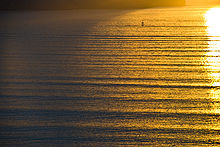- Swell (ocean)
-
"Ocean swell" redirects here. For the thoroughbred racehorse, see Ocean Swell.
 Breaking swell waves at Hermosa Beach, California
Breaking swell waves at Hermosa Beach, California
 Swell near Lyttelton Harbour, New Zealand
Swell near Lyttelton Harbour, New Zealand
A swell, in the context of an ocean, sea or lake, is a series surface gravity waves that is not generated by the local wind. Swell waves often have a long wavelength but this varies with the size of the water body, e.g. rarely more than 150 m in the Mediterranean, and from event to event, with swells occasionally longer than 700 m away from the most severe storms. Swells have a narrower range of frequencies and directions than the wind sea, because swell waves have dispersed from their generation area and have been dissipated.
Contents
Swell dissipation
The dissipation of swell energy is much stronger for short waves, which is why swells from distant storms are only long waves. The dissipation of waves with periods larger than 13 s is very weak but still significant at the scale of the Pacific Ocean.[1] These long swells lose half of their energy over a distance that varies from over 20000 km (half the distance round the globe) to just over 2000 km. This variation was found to be a systematic function of the swell steepness: the ratio of the swell height to the wavelength. The reason for this behaviour is still unclear but it is possible that this dissipation is due to the friction at the air-sea interface.
Swell dispersion and wave groups
Swells are often created by storms thousands of nautical miles away from the beach where they break, and the propagation of the longest swells is only limited by shorelines. For example swells generated in the Indian Ocean have been recorded in California after more than half a round-the-world trip.[2] This distance allows the waves comprising the swells to be better sorted and free of wikt:chop as they travel toward the coast. Waves generated by storm winds have the same speed and will group together and travel with each other, while others moving at even a fraction of a metre per second slower will lag behind, ultimately arriving many hours later due to the distance covered. The time of propagation from the source t is proportional to the distance X divided by the wave period T. In deep water it is t = 4πX / (gT) where g is the acceleration of gravity. For a storm located 10000 km away, swells with a period T=15 s will arrive 10 days after the storm, followed by 14 s swells another 17 hours later, and so forth.
This dispersive arrivals of swells, long periods first with a reduction in the peak wave period over time, can be used to tell the distance at which swells were generated.
Whereas the sea state in the storm has a frequency spectrum with more or less always the same shape (i.e. a well defined peak with dominant frequencies within plus or minus 7% of the peak), the swell spectra are more and more narrow, sometimes as 2% or less, as waves disperse further and further away. The result is that wave groups (called sets by surfers) can have a large number of waves. From about seven waves per group in the storm, this rises to 20 and more in swells from very distant storms.
Swell and surfing
Information on swell size and period is useful for surfers, as swells are generally more desirable to surf on than normal, locally-generated waves and chop. Swell size is typically the average height of the largest 33% of waves in a set, measured from the highest point of a wave (crest) to the lowest point (trough). Swell size is also known as the significant wave height. Period is the average length of time between each wave in a set. The significant period is the average period between the third largest waves in a wave record.
Swell and coastal impacts
Just like for all water waves the energy flux is proportional to the significant wave height squared times the group velocity. In deep water this group velocity is proportional to the wave period. Hence swells, with usually longer periods, can pack a lot more energy that shorter wind seas. Also, the amplitude of infragravity waves increases dramatically with the wave period (typically like the period squared), which results in higher run-up.
Since swell-generated waves are mixed with normal sea waves, they can be difficult to detect with the naked eye (particularly away from the shore) if they are not significantly larger than the normal waves. From a signal analysis point of view, swells can be thought of as a fairly regular (though not continual) wave signal existing in the midst of strong noise (i.e., normal waves and chop).
Swells were used by Polynesian navigators to maintain course when no other clues were available, such as on foggy nights.[4]
References
- ^ Observation of swell dissipation across oceans, F. Ardhuin, Collard, F., and B. Chapron, 2009: Geophys. Res. Lett. 36, L06607, doi:10.1029/2008GL037030
- ^ Directional recording of swell from distant storms, W. H. Munk, G. R. Miller, F. E. Snodgrass, and N. F. Barber, 1963: Phil. Trans. Roy. Soc. London A 255, 505
- ^ Wave Basics (Stormsurf)
- ^ Micronesian Navigation - University of Pennsylvania Museum of Archaeology and Anthropology
External links
- Coastalwatch (Australian swell forecasts)
- Magicseaweed (UK swell forecasting)
- Seabreeze (Australian swell forecasts)
- Swellnet (Australian swell forecasts)
- Stormsurf: Wave Basics (How swells are formed and measured)
- Waverider Buoys (Australian Swell Measuring Devices)
Categories:- Surfing
- Water waves
Wikimedia Foundation. 2010.


